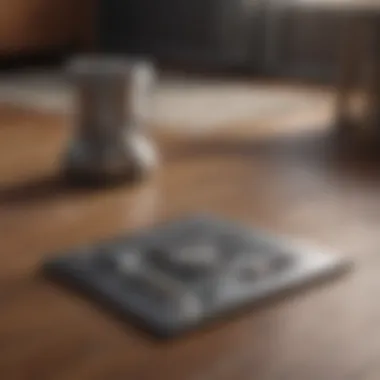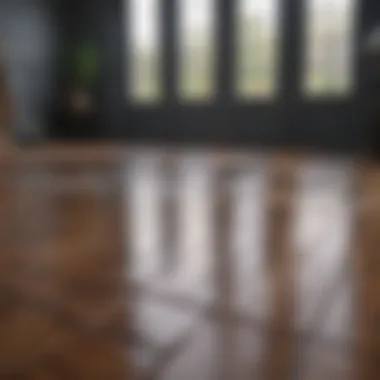Mastering the Art of Calculating Square Feet for Flooring Installation


Calculating square footage for flooring installation is a fundamental aspect of home improvement projects. Accurate measurements play a crucial role in ensuring the efficiency and precision of the installation process. This comprehensive guide will walk you through the necessary steps and practical methods to master the art of calculating square feet for flooring with expertise and meticulous attention to detail.
Practical Methods for Accurate Measurements
Before embarking on a flooring project, it is imperative to understand the significance of accurate measurements. Precision in calculating square footage can prevent material wastage and streamline the installation process. Begin by measuring the length and width of the room using a tape measure. Extend the tape measure from one end of the room to the other to obtain the length measurement. Repeat this process for the width, ensuring to measure from wall to wall. Take note of any alcoves or irregularities in the room that may affect the measurements.
Next, multiply the length by the width to calculate the total square footage of the room. For rooms with complex layouts or multiple sections, divide the room into smaller, more manageable areas and calculate the square footage of each segment separately. Add up the individual calculations to determine the overall square footage of the room accurately. It is advisable to round up the final measurement to account for any margin of error and ensure sufficient flooring material for the installation.
Tools for Precision and Efficiency
Utilizing appropriate tools can enhance the accuracy and efficiency of square footage calculations. A laser measuring device provides quick and precise measurements, minimizing errors and improving the overall precision of the calculation. Additionally, digital apps and software specifically designed for floor planning and measurements can streamline the process and offer detailed insights into the square footage requirements for flooring installation. These technological advancements in measurement tools contribute to a more seamless and efficient flooring project execution, saving time and resources in the process.
Introduction
In the realm of home improvement projects, one crucial aspect that often goes unnoticed is the meticulous art of calculating square feet for flooring installation. Such calculations are not merely about numbers; they are the foundation for a successful and seamless flooring endeavor. By mastering this fundamental skill, homeowners can ensure efficiency, cost-effectiveness, and precise execution in their renovation endeavors. This article delves deep into the nuances of determining square footage, equipping readers with the knowledge and tools needed to excel in their flooring projects.
Significance of Accurate Measurement
Avoiding Material Wastage
The avoidance of material wastage stands as a cornerstone in the realm of flooring installation. By accurately calculating square footage, individuals can procure just the right amount of materials needed for the project, eliminating unnecessary expenses and environmental impact. This meticulous approach not only showcases a commitment to efficiency but also reflects a profound understanding of resource optimization and sustainable practices.
Ensuring Cost Efficiency
Ensuring cost efficiency through accurate measurements is not just a financial strategy; it is a mark of prudence and foresight. By precisely calculating square footage, homeowners can avoid overspending on excess materials and labor costs. This financial prudence not only benefits the individuals directly involved but also contributes to a more sustainable and responsible approach to home renovation projects.
Facilitating Seamless Installation
A smooth and seamless installation process is the ultimate goal of any flooring project. Accurate measurements lay the groundwork for a hassle-free installation, minimizing the chances of errors, adjustments, and delays. By prioritizing precise calculations, individuals set the stage for a hassle-free and aesthetically pleasing outcome, transforming their living spaces with grace and efficiency.
Basic Concepts
Understanding Square Footage
At the core of any flooring project lies a thorough understanding of square footage. Recognizing the dimensions of a space in square feet not only aids in material estimation but also influences the overall aesthetic and functional aspects of the room. This foundational concept serves as the bedrock for informed decision-making and meticulous planning in any flooring endeavor.
Defining Flooring Requirements


Defining flooring requirements goes beyond mere material selection; it embodies a comprehensive approach to space optimization and design coherence. By defining the exact requirements for a flooring project, individuals can curate a space that harmonizes practical needs with aesthetic preferences. This concept not only streamlines the renovation process but also enhances the overall appeal and functionality of the living environment.
Tools Needed
Tape Measure
The tape measure emerges as the unsung hero in the realm of flooring calculations. Its versatility and precision make it an indispensable tool for accurate measurements and layout planning. By harnessing the power of a reliable tape measure, individuals can ensure accuracy in dimensions, leading to cohesive and visually appealing flooring installations.
Calculator
In the age of digital advancements, the humble calculator remains a vital companion for accurate flooring calculations. Its ability to swiftly process complex measurements and conversions streamlines the planning process, enabling individuals to make informed decisions regarding material quantities and budget allocations. The calculator's efficiency in numerical tasks makes it a must-have tool for seamless flooring projects.
Graph Paper
Graph paper's grid structure provides a visual representation of room dimensions and layout possibilities, making it an invaluable aid in flooring projects. By sketching floor plans and area divisions on graph paper, individuals can visualize the spatial distribution of materials and patterns, fostering a more precise and detailed approach to flooring calculations. The tactile nature of graph paper offers a hands-on solution to layout challenges, enhancing the planning process and guiding individuals towards optimal flooring outcomes.
Room Preparation
Room preparation is a crucial step in the process of calculating square feet for flooring installation. By focusing on this aspect, individuals can ensure the accuracy of their measurements and the efficiency of their project. Clearing the space and measuring irregular-shaped rooms are key components of room preparation that contribute significantly to the overall success of the flooring installation process.
Clearing the Space
Clearing the space involves two main tasks: removing furniture and cleaning the floor. Both are essential to creating a suitable environment for accurate measurement and seamless installation of the flooring.
Removing Furniture
Removing furniture is an integral part of room preparation as it allows for clear access to the entire floor area. By eliminating obstacles, individuals can accurately measure the space and avoid any miscalculations that could lead to material wastage or installation challenges. This step is crucial for ensuring precise calculations and a smooth flooring installation process. While removing furniture may require some effort, its benefits in terms of accuracy and efficiency cannot be overstated.
Cleaning the Floor
Cleaning the floor is another critical aspect of room preparation. A clean floor surface provides an optimal foundation for measuring and installing the flooring material. Removing dust, debris, and any existing flooring remnants ensures that measurements are not skewed and that the new flooring can be placed securely. A clean floor also promotes the longevity of the flooring material and enhances the overall appearance of the room. Although cleaning the floor may seem like a basic task, its impact on the success of the flooring installation project is substantial.
Measuring Irregular-Shaped Rooms
Measuring irregular-shaped rooms requires a strategic approach to ensure accurate calculations. Dividing the room into sections and calculating the area of each section are essential steps in accurately determining the square footage for flooring installation.
Dividing into Sections
Dividing the irregular-shaped room into manageable sections enables individuals to break down complex measurements into smaller, more manageable parts. By dividing the room, individuals can calculate the area of each section separately, simplifying the overall measurement process and minimizing the margin of error. This methodical approach ensures precise calculations and helps in determining the exact square footage required for the flooring material.


Calculating Area of each Section
Calculating the area of each section involves measuring the length and width of individual parts of the room and multiplying these dimensions to determine the square footage. This detailed approach allows for a more accurate estimation of the total square footage needed for the flooring installation. By calculating the area of each section separately, individuals can account for the unique shapes and dimensions of irregular rooms, ensuring that the flooring material covers the entire floor surface effectively.
Accounting for Doorways and Nooks
When measuring rooms with doorways and nooks, special considerations must be made to accommodate these features in the overall square footage calculation. Measuring door openings and adjusting measurements accordingly play a key role in obtaining precise measurements for flooring installation.
Measuring Door Openings
Measuring door openings is essential for accurately determining the area that will not be covered by the flooring material. By measuring the width and height of doorways, individuals can subtract this space from the total square footage to avoid excess material purchase and ensure a proper fitting of the flooring. Adjusting measurements according to door openings helps in optimizing material usage and avoiding unnecessary waste.
Adjusting Measurements
Adjusting measurements involves accounting for nooks, alcoves, or irregularities in the room that may impact the square footage needed for flooring installation. By making adjustments based on these features, individuals can calculate a more precise square footage estimate that reflects the actual floor space to be covered. This attention to detail is essential for ensuring that the flooring material fits snugly around doorways and other architectural elements, resulting in a seamless and professional installation process.
Calculating Square Footage
In this section, we delve into the essential aspect of Calculating Square Footage within the realm of flooring installation. Accurate measurement of square footage plays a crucial role in ensuring the efficiency and precision of flooring projects. By meticulously calculating the square footage of a room, individuals can mitigate material wastage, optimize cost-efficiency, and facilitate a seamless installation process. Emphasizing the significance of precise measurements sets the foundation for a successful flooring endeavor, underscoring the importance of meticulous planning and execution.
Method 1: Standard Rectangular Room
Length x Width Calculation
The Length x Width Calculation method stands out as a fundamental approach in determining square footage for standard rectangular rooms. By multiplying the length and width dimensions of a space, individuals can swiftly calculate the total square footage. This method's simplicity and effectiveness make it a popular choice for accurately assessing square footage in linear and symmetric room layouts. Its straightforward application provides a quick solution for estimating required materials and gauging project scopes. Although uncomplicated, the Length x Width Calculation method requires precise measurements to avoid inaccuracies in flooring quantity assessments. Implementing this approach ensures a reliable foundation for subsequent installation steps.
Handling Imperial and Metric Units
Navigating between imperial and metric units is a critical aspect of the square footage calculation process. Adapting measurements from feet to meters or vice versa demands attention to detail and precision. Incorporating both systems seamlessly enhances flexibility and caters to diverse measurement preferences. By accommodating various measurement units, individuals can accurately translate room dimensions and flooring requirements, aligning with industry standards and project specifications. However, ensuring consistency and accuracy between different unit systems is paramount to prevent errors in material estimations and installation planning. Integrating imperial and metric units harmoniously improves accessibility and comprehension for a wider audience, promoting standardized practices in flooring measurements.
Method 2: Complex Room Shapes
Breakdown into Smaller Sections
Tackling complex room shapes involves breaking down expansive areas into manageable sections for precise square footage calculations. Segmenting irregular layouts into smaller subsections allows for a detailed assessment of each space component. By dividing intricate floor plans into digestible units, individuals can accurately measure and evaluate unique room configurations, ensuring comprehensive coverage of all surface areas. This method's structured approach promotes meticulous analysis of complex room shapes, enabling efficient measurement processes and accurate calculations. A systematic breakdown is instrumental in handling challenging floor layouts and maximizing accuracy in determining flooring requirements.
Summing Up Areas


Summing up individual section areas consolidates segmented measurements into a cohesive total square footage for complex room shapes. By aggregating calculated areas from each smaller section, individuals obtain an accurate representation of the entire room's square footage. This summation process elucidates the cumulative flooring needs across intricate layouts, offering a comprehensive overview of material requirements. Summarizing areas ensures that no space is overlooked during the measurement phase, safeguarding against underestimations and potential discrepancies in flooring quantities. Collating segmented areas into a collective sum optimizes precision in assessing flooring needs, acting as a crucial step in mastering complex room shape calculations.
Calculating Waste Allowance
Adding Extra Square Footage
Incorporating additional square footage as a waste allowance accounts for unforeseen factors and ensures sufficient material coverage during flooring installation. Allocating extra square footage beyond the measured requirements cushions against unexpected contingencies like fitting adjustments or cutting variations. This surplus allowance safeguards project continuity and minimizes the risk of material shortages, averting delays and rework. By preemptively including extra square footage in calculations, individuals mitigate project disruptions and streamline the installation process, underscoring the importance of thorough planning and foresight in flooring projects.
Considering Pattern Matching
Deliberating on pattern matching considerations guides efficient square footage calculations for flooring installations. Factoring in pattern repetitions and alignment requirements necessitates meticulous planning to synchronize flooring elements seamlessly. Choosing pattern-matching strategies that optimize material usage and accentuate room aesthetics contributes to cohesive design implementations. However, balancing pattern intricacies with precise square footage estimations requires attention to detail and strategic placement. Addressing pattern matching nuances enhances the visual impact of flooring layouts while ensuring accurate material assessments for intricate design schemes. Engaging in thoughtful pattern considerations elevates the overall flooring installation process, aligning aesthetics with functional requirements for a cohesive and harmonious result.
Final Considerations
In the realm of calculating square footage for flooring, final considerations play a pivotal role in ensuring the success and smooth progression of any home improvement project. These considerations serve as the ultimate checkpoint before proceeding with the flooring installation. By double-checking measurements, factoring in waste allowance, and taking into account irregularities in room shapes, individuals can preempt many potential issues that may arise during the installation process. Emphasizing the importance of meticulous planning and precision, final considerations encompass various aspects that contribute to the overall quality and efficiency of the flooring project.
Double-Checking Measurements
Ensuring Accuracy
When it comes to double-checking measurements, ensuring accuracy stands out as a fundamental aspect that cannot be overlooked. By meticulously verifying the dimensions of the room, individuals can eliminate errors and discrepancies that might result in incorrect material estimations. The key characteristic of ensuring accuracy lies in its ability to provide a reliable foundation for the entire flooring installation process, thereby reducing the likelihood of costly mistakes and rework. Its unique feature lies in the meticulous attention to detail, ensuring that every measurement aligns with the actual dimensions of the space.
Avoiding Costly Mistakes
One of the primary goals of double-checking measurements is to avoid costly mistakes that could potentially derail the entire flooring project. By carefully reviewing all measurements and calculations, individuals can preemptively identify any inaccuracies or oversights that may lead to material wastage or insufficient coverage. The key characteristic of avoiding costly mistakes is its proactive approach to error prevention, thus safeguarding the project's timeline and budget. Its unique feature lies in the ability to mitigate risks associated with measurement errors, ultimately saving valuable resources and time in the long run.
Consulting Professionals
Seeking Expert Advice
Consulting professionals for expert advice can significantly enhance the precision and efficiency of calculating square footage for flooring installation. Experts in the field possess specialized knowledge and experience that can provide valuable insights and recommendations tailored to specific project requirements. The key characteristic of seeking expert advice is the access to specialized expertise, ensuring that all aspects of the flooring project are meticulously considered and optimized for the best results. Its unique feature lies in the personalized guidance offered by professionals, helping individuals navigate complex calculations and decision-making processes with confidence.
Requesting Quotes
Requesting quotes from professional flooring contractors or suppliers is a prudent step in the planning phase of any flooring project. By obtaining detailed quotes that outline the cost of materials, labor, and additional services, individuals can gain a comprehensive understanding of the financial implications involved. The key characteristic of requesting quotes is its transparency in pricing, allowing individuals to budget effectively and make informed decisions based on accurate cost estimates. Its unique feature lies in the opportunity to compare different quotes and choose the most cost-effective and reputable option for the flooring installation.
Recording Measurements
Maintaining Documentation
Maintaining detailed documentation of all measurements and calculations is essential for ensuring the accuracy and consistency of the flooring project. By systematically recording the dimensions of each room, including any irregularities or special considerations, individuals can reference this information throughout the installation process. The key characteristic of maintaining documentation is its role in providing a reliable reference point for verifying measurements and making informed decisions on material quantities and layout. Its unique feature lies in the organization and accessibility of the documentation, streamlining communication and coordination between all parties involved in the project.
Facilitating Smooth Installation
Facilitating a smooth installation hinges on efficient coordination and preparation based on recorded measurements and documentation. By utilizing the documented information to create detailed layouts and plans, individuals can streamline the installation process and minimize disruptions. The key characteristic of facilitating smooth installation is the seamless integration of measurements and documentation into the execution phase, ensuring that all stakeholders are aligned and informed every step of the way. Its unique feature lies in optimizing the workflow and resource allocation, thereby enhancing the overall efficiency and quality of the flooring installation.



